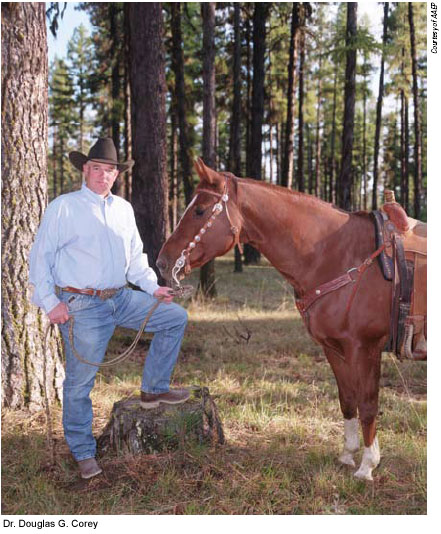The track to AAEP presidency
Dr. Douglas G. Corey spent many summers in his youth driving a wheat combine, hauling hay, building fences, and performing many other chores required on his family's wheat and cattle ranch in Pendleton, Ore. While he immensely enjoyed being outdoors, he knew he didn't always want to work on the ranch. It was then that Dr. Corey decided to pursue large animal medicine.

"I felt that being a veterinarian might be another step, so to speak, than being on the ranch all the time," he said. "It also gave me the opportunity to be an active participant in our ranching operations when I came back to Pendleton."
A resident of Adams, Ore., Dr. Corey travels to Pendleton to provide veterinary care to the horses and cattle on the ranch. He is also involved in other aspects as a member of the ranch's board of directors.
Dr. Corey is a partner at the Associated Veterinary Medical Center, a six-veterinarian mixed practice in Walla Walla, Wash. He joined the center in 1978 and practices equine veterinary medicine and some surgery.
Dr. Corey is a past president and board member of the Oregon VMA. He earned the Oregon Veterinarian of the Year title in 1997.
In December, Dr. Corey was named the 2007 president of the American Association of Equine Practitioners. With more than 9,000 members, the association recently had record-breaking attendance at its annual convention. Dr. Corey was the 2006 program chair for the event.
The track to the AAEP presidency began to take shape for Dr. Corey when he joined the association in 1976. During that year, he earned his DVM degree from Colorado State University. Shortly after, he traveled to Franklin, Tenn., to practice with Dr. DeWitt Owen, a past AAEP president. Two other past presidents, Drs. Robert Shideler and O.R. Adams, were mentors of Dr. Corey.
"They guided me to the AAEP, he said about his mentors. "They thought, if you're going to be involved in equine medicine and surgery, you need to be involved in the AAEP."
Dr. Corey also spent several months practicing with Dr. G. Marvin Beeman at the Littleton Large Animal Clinic in Littleton, Colo.
"When you're around people like that, they set examples of how to be a good equine practitioner," he said. "One part of that was being an AAEP member and really participating and giving back to the profession."
Before earning the association's top post, Dr. Corey served as chairman for the AAEP Research, Public Relations, Membership, Equine Welfare, and 50th Anniversary committees. He was on the AAEP board of directors from 1995-1998.
As AAEP president, Dr. Corey will follow the association's strategic plan, which was renewed in 2005.
"Dr. (Thomas D.) Brokken did a great job for the AAEP in leading us last year, and I will try to maintain a steady course of what he has laid out for us," he said.
Remaining a relevant organization to members is one of three main components of the strategic plan. With a new membership development committee in place, Dr. Corey said, the AAEP remains committed to helping members be "better and happier practitioners."
Also, a task force was developed to address lifestyle issues that are important to members.
"Many practitioners today, both men and women, wish to balance career and family," he said. Increased debt and starting salaries are also concerns for new graduates.
Enhancing continuing education is another component of the strategic plan. "We're the world's premier provider of CE for equine veterinary medicine," he said. "We need to continue that and always look at how we provide our continuing education, and how to change it if needed."
Dr. Corey said in 2007 the AAEP will look into offering more online continuing education for members who are unable to attend the annual convention or other AAEP meetings.
The third component of the strategic plan is public advocacy. "We need to strengthen the AAEP's influence in public-policy decision making," he said. "We will be asking our members to become more involved in this process."
Along with these three components, Dr. Corey said animal welfare will remain one of his top priorities. For the past 23 years, he has addressed horse welfare issues as a volunteer with the Professional Rodeo Cowboys Association. At the PRCA, he has helped establish a full-time animal welfare position and develop minimum care guidelines for rodeo livestock as well as other welfare rules and guidelines. He has served as chair of the AVMA Animal Welfare Committee and is a member of the American Horse Council's Equine Welfare Committee. He participates in the National Final Rodeo's On Call program for media relations each year.
"Today, animal welfare is brought up everyplace you go and at all forums. It is of the utmost importance to the equine industry," he said. "If we keep in mind what's best for the health and welfare of horses, then we should be correct in our decisions."